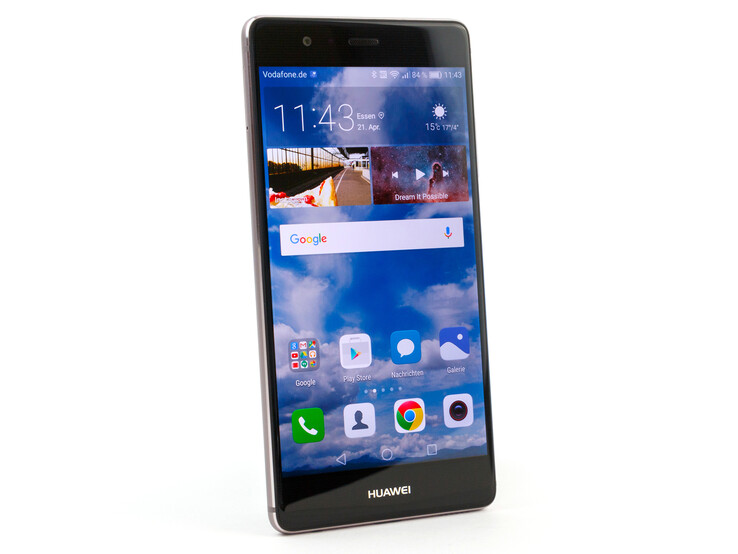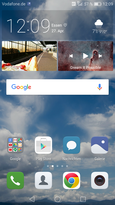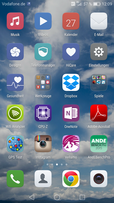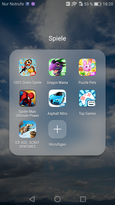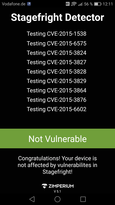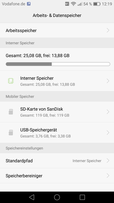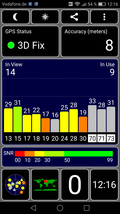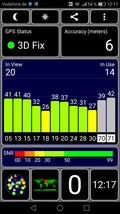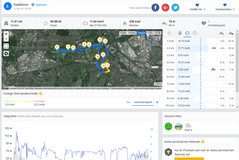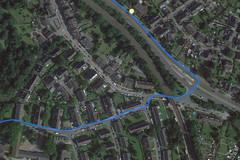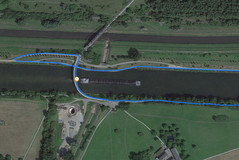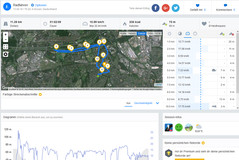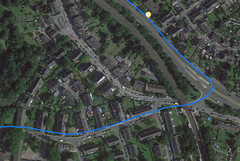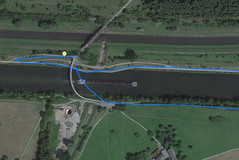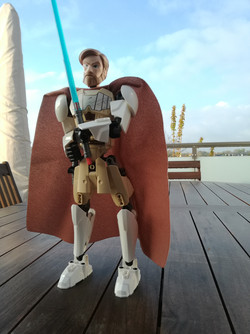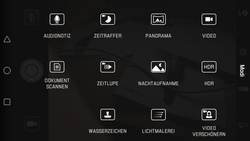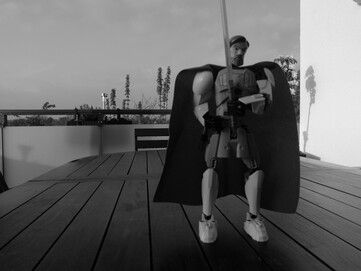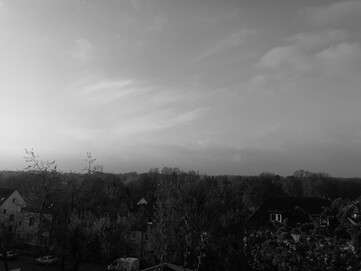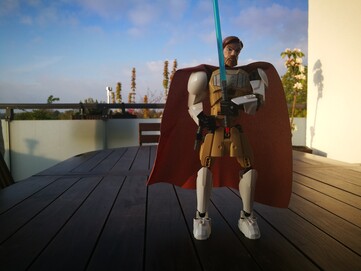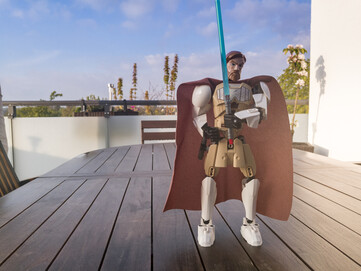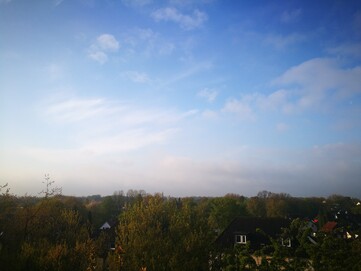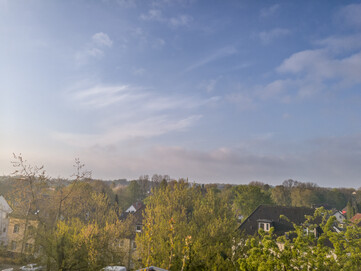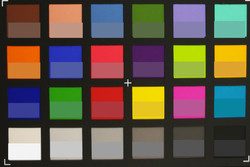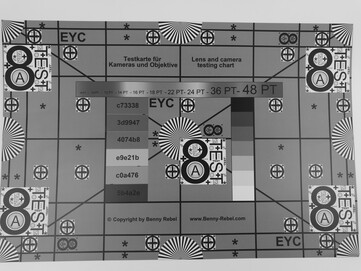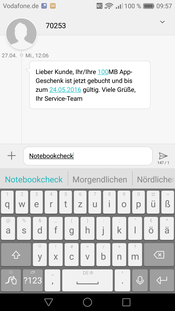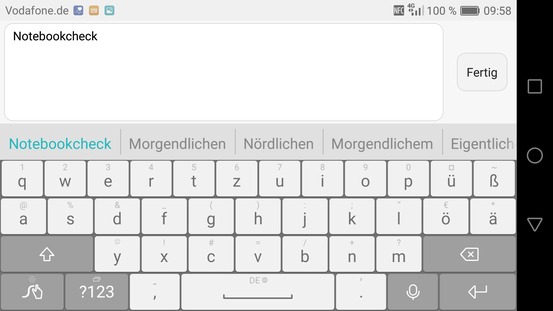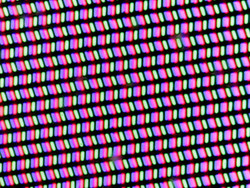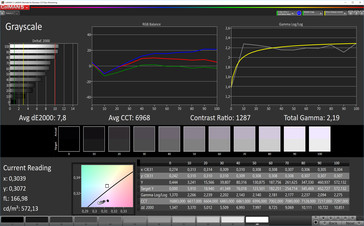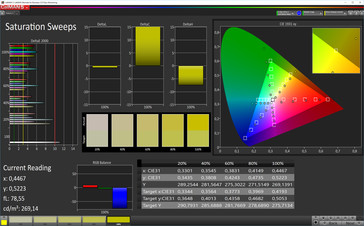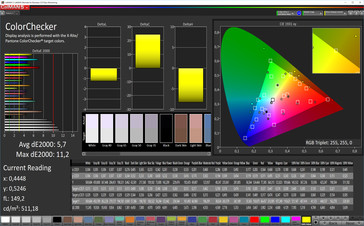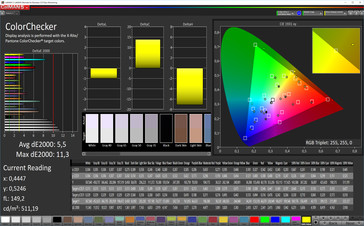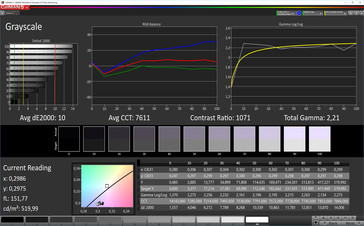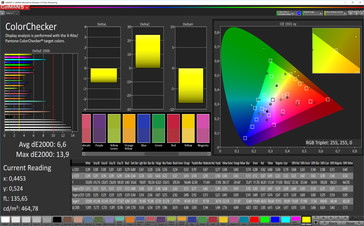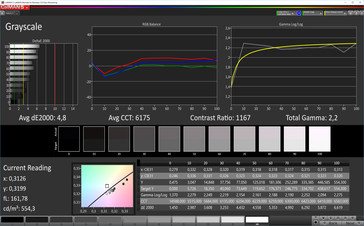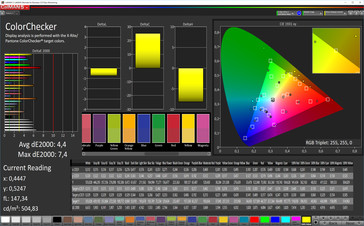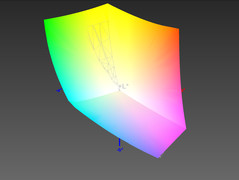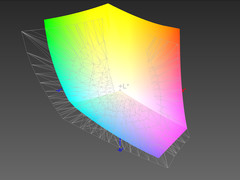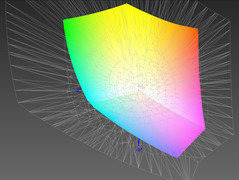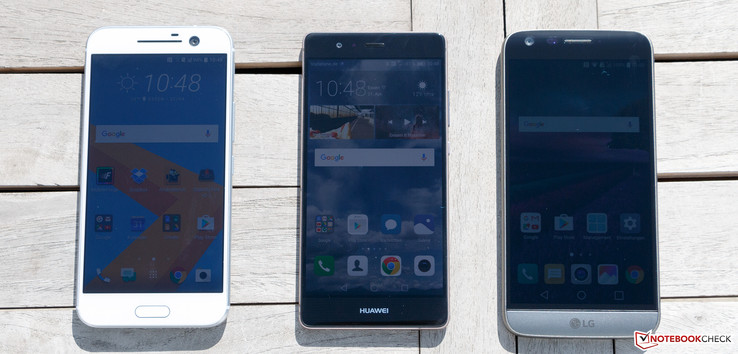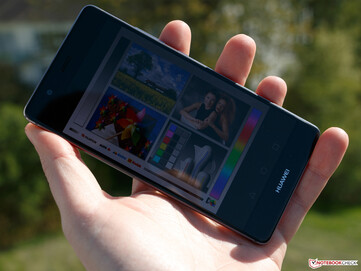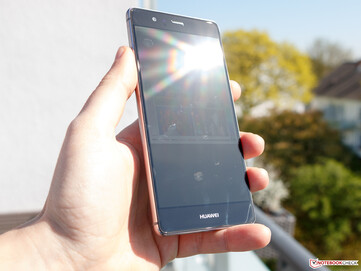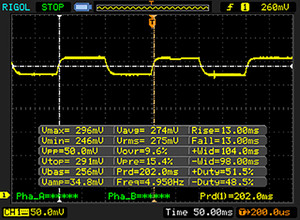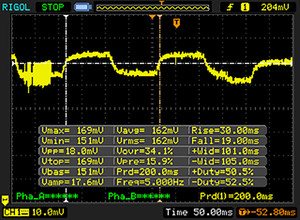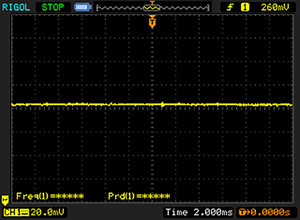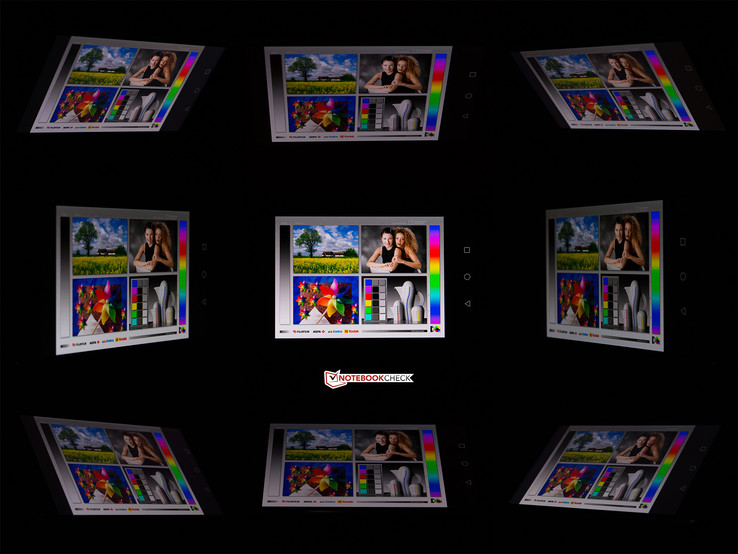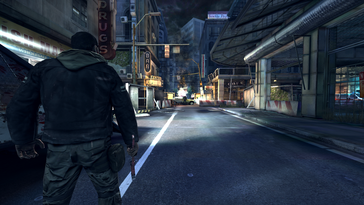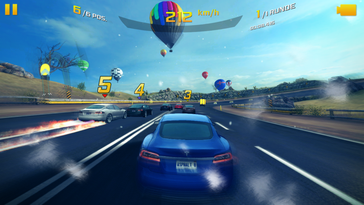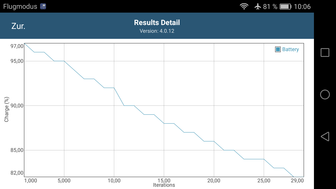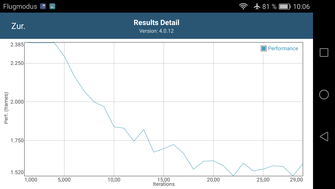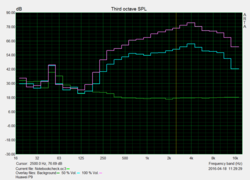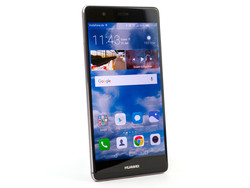Huawei P9 Smartphone Review
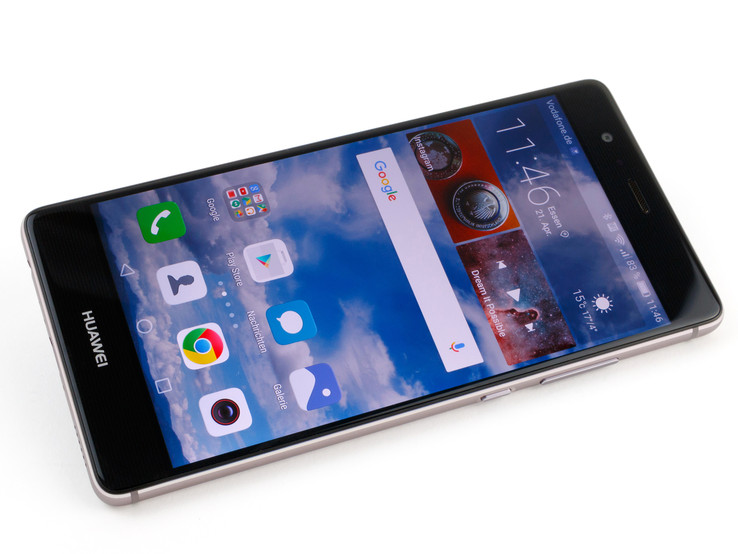
For the original German review, see here.
The new Huawei P9's design looks like a successful combination of the P8 and Nexus 6P. The device has a 5.2-inch IPS panel, the latest Kirin 955 SoC, LTE Cat. 6 and micro-SD support. Our review sample comes with 3 GB of working memory and 32 GB of flash memory; a dual-SIM model is not intended for Europe. A premium model with 4 GB of working memory and/or an internal storage of 64 GB is also planned - but not yet for Europe, either. The larger configurations will be reserved for Huawei's P9 Plus. This model also has a 5.5-inch screen with press-touch, a stronger battery, stereo speakers and an infrared sensor.
Huawei has also modified the price. The P8 was initially sold for 499 Euros (~$573), but the manufacturer is now asking 569 Euros (~$654) for its flagship smartphone. The Plus model is to be priced at 699 Euros (~$803). Although Huawei is still somewhat cheaper than the premium models by Samsung, LG, Apple and Co., it is closing in on them. Upon inquiry, the Chinese manufacturer replied that it sees itself on the same quality level as other premium manufacturers, and is therefore approaching this price range.
Apple's iPhone 6s, Samsung's Galaxy S7, OnePlus' 2, the Moto X Force, Microsoft's Lumia 950, Sony's Xperia Z5 and LG's G5 und HTC 10 are rivals of Huawei's P9.
Case
Huawei's P9 feels good in the hand. The casing is still made of an aluminum unibody, but the edges are rounder than those of the predecessor, which ensures a pleasant grip. Although the metal back is relatively sleek, it is not as extreme as in devices with an entirely glass back. According to the manufacturer, the smartphone is now half a millimeter (~0.02 in) thicker. We measured a height of 7.1 millimeters (~0.28 in). This is due to the larger battery that simply needs more space. Once again, it is not removable.
Huawei's P9 is impervious to warping attempts. No matter how much force we applied, the smartphone did not produce any creaking sounds. Only strong pressure on the screen leads to marginal wave formation. The gaps are very even, and the card slot closes flush with the rest of the casing. The trays for the nano-SIM and micro-SD card are also made of metal, which results in a superb overall impression in terms of build quality.
Connectivity
Huawei's P9 has quite a lot to offer in terms of connectivity, but also has some gaps. Although, the USB Type-C port only operates in the 2.0 transmission standard, at least it supports OTG, making it possible to connect external storage or input devices. When connected to a computer, the quick start menu makes it easy to select whether the PC is to access only photos or the entire data storage. Selecting the latter creates a virtual CD drive on the computer, over which the HiSuite software can be installed. It can be used to back up the smartphone, manage data or for updating.
The micro-SD card reader supports cards with a maximum capacity of 128 GB. This sounds great at first, but the smartphone does not support the feature of using the SD memory as an additional internal storage or installing or moving apps to the card (App2SD). Hopefully, these features will be added via an update.
The infrared sensor is reserved for the P9 Plus, and the P9 does not have a radio receiver, either. On the other hand, the latest Bluetooth 4.2 LE standard and NFC are included. Furthermore, Wi-Fi Direct and Miracast are supported for transmitting data and videos.
Software
As with the Mate 8, Google's Android 6.0 Marshmallow is installed on Huawei's P9. The Chinese manufacturer covers it with the proprietary EMUI 4.1 user interface (UI) that does not feature an app drawer. Our review sample is configured with the EVA-L09C432B135 build version.
The small collection of preloaded games was rather annoying. However, it can be completely deleted. Otherwise, the smartphone does not come with any bloatware. As well as a health app, the familiar phone manager for system maintenance is also present. Little helpers, such as a mirror, flashlight, recorder, memo and backup app, are also preloaded.
Like the P8, the system runs very smoothly and lags are rare.
Update 12/04/2017: Huawei has released firmware version B391 (2.4 GB) bringing the new moments feature to the P9. Basically, moments work like Apple’s Live Photos on the iPhone or Microsoft’s namesake on the Lumia 930 and creates a short 2 second video prior to the moment of shutter release. Google’s security patches have been updated to 09/01/2017 and EMUI has been updated to version 5.0.1. In addition, the new firmware also comes with the Quik app preloaded. Fortunately, it can be uninstalled if necessary.
Communication & GPS
Huawei's P9 accesses the mobile Internet via HSPA+ (max. 42 Mbit/s downstream) or high-speed LTE Cat. 6 (max. upstream: 50 Mbit/s; downstream: 300 Mbit/s). Unfortunately, LTE Cat. 9 or faster is not supported. The frequency coverage is very wide and should ensure good reception anywhere in the world. This makes the fact that the dual-SIM model of the P9 is not available in Europe more tolerable. The manufacturer has installed three antennas in the casing for an even better reception, a feature no other smartphone currently has.
Huawei's P9 connects to the local Wi-Fi via the latest IEEE 802.11 a/b/g/n/ac standards. Therefore, it transmits in both the 2.4 GHz and 5.0 GHz frequency bands. The range of the module is good; a strong signal was still displayed 15 meters (~49 ft) away from the access point (Devolo dLAN 1200+ Wifi ac), and browsing the Internet was still fast. The improved Signal+ technology helps to switch more efficiently between different networks, and better assess the quality.
We tested Miracast in conjunction with an Amazon Fire TV Stick. Connecting was fast and easy. Simple contents, such as the user interface, were displayed correctly. However, when scrolling through the gallery it always took a moment before the next photo was loaded. Although rendering a video via the connection functioned with sound, it stuttered very heavily.
Huawei's P9 uses the GPS, GLONASS and BeiDou satellite networks for localization. It displayed an accuracy of 8 meters (~26 ft) indoors. The smartphone is even more accurate outdoors with up to 6 meters (~20 ft). Some other handsets do a better job here.
A deviation of approximately 2% (220 m/~722 ft) is seen in the direct comparison with the Garmin Edge 500 bike computer. The reason for this is particularly evident in the area of the turning point. The update intervals of localization are slightly too long and lack some accuracy. Nevertheless, the performance is enough for navigating by car or bike.
Telephone & Call Quality
The phone app in Huawei's P9 presents the familiar looks of other models.
The smartphone's call quality is compelling. The callers' voices are transmitted clearly at both ends, and noise suppression also functions well. The background music was completely suppressed and no longer audible. The speaker also impressed us. The P9 was placed on a table during the test calls, but we were always well understood. Noise suppression is not quite as good then, but it is still noticeable.
Cameras
An 8 MP camera (3264x2448 pixels) with an aperture of f/2.4 is situated on the front. It still functions decently in low-light environment and has many features. Once again, the beauty mode familiar from the P8 that offers 10 soft-focus levels is installed. It can now be used in video mode also, but reduces the recording quality to 720p as opposed to 1080p that is possible in the standard mode. The same is true for time lapse mode. The sound is recorded in stereo quality and makes a good impression.
The self-proclaimed showpiece of Huawei's P9 is the 12 MP dual-camera (max. 3968x2976 px; 4:3) that according to the company has been developed in cooperation with Leica. It imports the flair of typical Leica photos in mobile photography. The jointly-developed image algorithm is to provide better results, especially in low light conditions. Huawei even speaks of a new era of smartphone photography. The dual-camera has two different sensors. The first is a conventional RGB sensor and the second takes only black/white photos. The black/white sensor is to collect more image data in low light.
Huawei has also expanded the camera's Pro mode. In addition to diverse settings, it supports photos in DNG format. The light sensitivity ranges from ISO 50 to 3200 and the exposure times from 1/4000 to 30 seconds. However, the Live View mode does not function reliably in long exposure, which we had also observed in the Galaxy S7. Although the Pro mode is available when using the black/white sensor, it is not possible to shoot DNGs.
The daylight photo quality of Huawei's P9 appealed to us. Photos are very dynamic and sharp. Colors tend to look warmer and stronger, but this is not annoying. The opposite is true: It gives the photos a unique look. The photos generally make a very high-contrast impression. The quality decreases in difficult light conditions, but the P9 still does a good job. The white balance in particular is better than those of the rivals; outlines remain clear and there is not as much image noise. We see the P9 before the iPhone 6s and LG G5 in the comparison field. However, it cannot compete with the low-light performance of the Galaxy S7.
Huawei's P9 records video only in Full HD (1920x1080 px; 30 or 60 FPS). The recordings in 60 frames per second are visibly darker. Users who are happy with 1080p at 30 FPS will be provided with a very good result. Unfortunately, it is not possible to record in Ultra HD, and special recording modes such as time lapse and slow-motion are only possible in 720p. On the other hand, the recorded stereo sound is always really good.
Sharpness & Color Accuracy
We photographed ColorChecker Passport with Huawei's P9 in controlled light conditions. The camera's automatic mode is used and the photo is not edited afterwards. The practical impression is confirmed: Colors are highly saturated and the white balance is rather too warm.
We photographed our test chart under the same conditions. We used the RGB and the black/white sensor separately. The color sensor reproduces very sharp outlines and does not have any problems with color gradients. Light blurriness is only seen at the edges in maximum zoom, which is not uncommon. The black/white sensor in the P9 delivers slightly better results and the peripheral areas are somewhat sharper.
Accessories
In addition to a quick start guide and the mandatory safety instructions, Huawei's P9 comes with a modular Quick Charger with a nominal output of 10 watts (5 volts, 2 amperes). Besides the included in-ear headset, a data cable with a conventional USB Type-A on one end and Type-C on the other is also included in the box.
Apparently, a free case is included when purchasing the handset in China.
Warranty
Huawei strongly believes in its handset and this is reflected in the warranty. 36 months is included when purchasing the P9. That is a real statement in the smartphone sector and makes the smartphone also interesting to the business sector. For this, the smartphone has to be connected to a free Huawei account.
Huawei even tops that. The screen is replaced for free within the first three months of purchase in case of accidental damage. The smartphone will also be replaced with a new handset within the first three months in case of hardware failures.
Input Devices & Handling
The Corning Gorilla Glass surface of Huawei's P9 ensures superb gliding qualities on the touchscreen. Inputs are implemented quickly and accurately. We did not notice any issues in the peripheral areas. Huawei's proprietary keyboard, familiar from handsets such as the Mate 8 or P8, is installed. An alternative layout can be downloaded from the Play Store if preferred.
Once again, the touchscreen supports inputting with a knuckle, which also functions reliably with some practice. Screenshots are created by tapping twice on the screen with a knuckle. Creating full-length screenshots is a useful feature, as it conveniently allows capturing entire websites, for example.
The physical buttons on the casing's right have a firm, short drop and function accurately. The power button is slightly roughened for discerning it with a finger. The controls are incorporated firmly in the casing and they make a high-quality impression.
A notification LED is situated behind the earpiece. Unfortunately, it can only be turned on and off in the settings; it cannot be configured otherwise.
The P series now receives a fingerprint scanner with the launch of the P9. It is on the back and offers the same features as in the Mate S. It can be used for pulling down the notification bar, to scroll through the gallery or as camera release. The detection accuracy and speed have been improved. Unlike the level 2 scanner in the Mate S, a level 4 module is now installed in the P9. Apparently, it uses a three dimensional image of the fingerprint. The scanner functioned reliably and very fast in practice.
Display
The screen in Huawei's P9 has a size of 5.2 inches and once again uses the IPS NEO technology familiar from the P8. The Chinese manufacturer still holds tight to the Full HD resolution, but has announced that they will install higher resolution screens in future due to VR (we reported). The decision is quite reasonable, but the current resolution is perfectly adequate for all other tasks and achieves a decent pixel density of 424 PPI.
Huawei has further increased the screen's brightness, which now achieves a high 582 cd/m² in the center. Unfortunately, this affects the black value slightly and it remains just below 0.4 cd/m². Although this is still a good outcome, overall, the screen's contrast lags slightly behind the P8's panel. The measured rates do not change when the ambient light sensor is enabled or when evenly distributing bright and dark areas over the screen. The illumination of 91% is very homogeneous. Particularly praiseworthy: We did not observe clouding on our review sample even in absolute darkness.
The P9 Plus is delivered with a 5.5-inch Super AMOLED panel.
| |||||||||||||||||||||||||
Brightness Distribution: 91 %
Center on Battery: 582 cd/m²
Contrast: 1532:1 (Black: 0.38 cd/m²)
ΔE ColorChecker Calman: 4.4 | ∀{0.5-29.43 Ø4.78}
ΔE Greyscale Calman: 4.8 | ∀{0.09-98 Ø5}
99.44% sRGB (Argyll 1.6.3 3D)
77.78% AdobeRGB 1998 (Argyll 1.6.3 3D)
87.8% AdobeRGB 1998 (Argyll 3D)
99.5% sRGB (Argyll 3D)
93.8% Display P3 (Argyll 3D)
Gamma: 2.2
CCT: 6175 K
| Huawei P9 IPS-NEO, JDI, 1920x1080, 5.2" | Huawei P8 IPS-NEO, 1920x1080, 5.2" | Apple iPhone 6S IPS, 1334x750, 4.7" | Samsung Galaxy S7 SAMOLED, 2560x1440, 5.1" | Microsoft Lumia 950 AMOLED, 2560x1440, 5.2" | OnePlus 2 IPS, 1920x1080, 5.5" | Sony Xperia Z5 IPS, 1920x1080, 5.2" | |
|---|---|---|---|---|---|---|---|
| Screen | -4% | -1% | 15% | 1% | -3% | -44% | |
| Brightness middle (cd/m²) | 582 | 453 -22% | 552 -5% | 350 -40% | 292 -50% | 451 -23% | 669 15% |
| Brightness (cd/m²) | 563 | 439 -22% | 549 -2% | 351 -38% | 298 -47% | 446 -21% | 624 11% |
| Brightness Distribution (%) | 91 | 91 0% | 87 -4% | 98 8% | 92 1% | 90 -1% | 85 -7% |
| Black Level * (cd/m²) | 0.38 | 0.28 26% | 0.39 -3% | 0.3 21% | 0.68 -79% | ||
| Contrast (:1) | 1532 | 1618 6% | 1415 -8% | 1503 -2% | 984 -36% | ||
| Colorchecker dE 2000 * | 4.4 | 4.7 -7% | 3.4 23% | 2.04 54% | 2.48 44% | 3.84 13% | 7.96 -81% |
| Colorchecker dE 2000 max. * | 7.4 | 3.25 56% | |||||
| Greyscale dE 2000 * | 4.8 | 5.03 -5% | 4.16 13% | 1.63 66% | 1.97 59% | 3.97 17% | 10.95 -128% |
| Gamma | 2.2 100% | 2.27 97% | 2.21 100% | 2.07 106% | 2.06 107% | 2.46 89% | 2.61 84% |
| CCT | 6175 105% | 7439 87% | 7288 89% | 6391 102% | 6640 98% | 7283 89% | 7402 88% |
| Color Space (Percent of AdobeRGB 1998) (%) | 77.78 | 72.04 -7% | 62.18 -20% | 86.86 12% | 58.07 -25% | ||
| Color Space (Percent of sRGB) (%) | 99.44 | 95.93 -4% | 99.35 0% | 90.14 -9% |
* ... smaller is better
We used our photospectrometer and CalMAN analysis software for checking the color reproduction accuracy. Although an improvement over the former P8 is noticed, the rivals can reproduce colors even more accurately. Aberrations from the reference colors are particularly visible in the standard settings. The grayscale levels display a bluish tint, and some deviation is also seen in mixed colors. The warm color setting is most accurate, should precision be needed. However, this will annoy very few users since it is an issue of fine color differences. Fortunately, the color space coverage is very wide.
Display Response Times
| ↔ Response Time Black to White | ||
|---|---|---|
| 26 ms ... rise ↗ and fall ↘ combined | ↗ 13 ms rise | |
| ↘ 13 ms fall | ||
| The screen shows relatively slow response rates in our tests and may be too slow for gamers. In comparison, all tested devices range from 0.1 (minimum) to 240 (maximum) ms. » 61 % of all devices are better. This means that the measured response time is worse than the average of all tested devices (20.2 ms). | ||
| ↔ Response Time 50% Grey to 80% Grey | ||
| 49 ms ... rise ↗ and fall ↘ combined | ↗ 30 ms rise | |
| ↘ 19 ms fall | ||
| The screen shows slow response rates in our tests and will be unsatisfactory for gamers. In comparison, all tested devices range from 0.165 (minimum) to 636 (maximum) ms. » 84 % of all devices are better. This means that the measured response time is worse than the average of all tested devices (31.7 ms). | ||
Screen Flickering / PWM (Pulse-Width Modulation)
| Screen flickering / PWM not detected | |||
In comparison: 53 % of all tested devices do not use PWM to dim the display. If PWM was detected, an average of 8145 (minimum: 5 - maximum: 343500) Hz was measured. | |||
Performance
The strongest SoC that the Chinese company's in-house chip maker can provide is installed in Huawei's P9: the HiSilicon Kirin 955. The SoC is almost identical to the Kirin 950 sister model found in the Mate 8. Only the Cortex A72 cluster clocks approximately 200 MHz faster. The processor performance should therefore be roughly 8% higher. The ARM Mali T880 graphics unit is also installed. Consequently, the total package is very strong, but will not reach the level of the latest Exynos 8890 or Snapdragon 820.
The benchmarks reveal several small surprises. Firstly, the P9 presents an outstanding system performance and, as with the Mate 8, clearly outruns all rivals in PCMark for Android. Secondly, apparently the P9 cannot completely retrieve the SoC's extra power. It is only 4% faster than its sibling in Geekbench, and both are on par in GFXBench 3.1. However, the latter is more of a GPU-intensive benchmark so that this is not as remarkable. However, the Mate 8 is sometimes marginally faster in physics calculations in 3DMark. The P9 probably has difficulties in dealing with the additional heat in a tight space, and thus its faster SoC does not bring any advantages.
As PCMark confirms, the system performance is very good. Barely any lags are noticed subjectively; at most when a demanding app had just been closed.
| PCMark for Android - Work performance score (sort by value) | |
| Huawei P9 | |
| Huawei P8 | |
| Huawei Mate 8 | |
| Google Nexus 5X | |
| Samsung Galaxy S7 | |
| Motorola Moto X Force | |
| Sony Xperia Z5 | |
| AnTuTu v6 - Total Score (sort by value) | |
| Huawei P9 | |
| Huawei Mate 8 | |
| Samsung Galaxy S7 | |
| Motorola Moto X Force | |
| GFXBench 3.0 | |
| on screen Manhattan Onscreen OGL (sort by value) | |
| Huawei P9 | |
| Huawei P8 | |
| Huawei Mate 8 | |
| Google Nexus 5X | |
| Microsoft Lumia 950 | |
| Apple iPhone 6S | |
| Samsung Galaxy S7 | |
| Motorola Moto X Force | |
| Sony Xperia Z5 | |
| 1920x1080 1080p Manhattan Offscreen (sort by value) | |
| Huawei P9 | |
| Huawei P8 | |
| Huawei Mate 8 | |
| Google Nexus 5X | |
| Microsoft Lumia 950 | |
| Apple iPhone 6S | |
| Samsung Galaxy S7 | |
| Motorola Moto X Force | |
| Sony Xperia Z5 | |
| GFXBench 3.1 | |
| on screen Manhattan ES 3.1 Onscreen (sort by value) | |
| Huawei P9 | |
| Huawei Mate 8 | |
| Samsung Galaxy S7 | |
| Motorola Moto X Force | |
| Sony Xperia Z5 | |
| 1920x1080 Manhattan ES 3.1 Offscreen (sort by value) | |
| Huawei P9 | |
| Huawei Mate 8 | |
| Samsung Galaxy S7 | |
| Motorola Moto X Force | |
| Sony Xperia Z5 | |
| Lightmark - 1920x1080 1080p (sort by value) | |
| Huawei P9 | |
| Huawei Mate 8 | |
| Samsung Galaxy S7 | |
| Basemark ES 3.1 / Metal - offscreen Overall Score (sort by value) | |
| Huawei P9 | |
| Huawei Mate 8 | |
| Apple iPhone 6S | |
| Samsung Galaxy S7 | |
Google's Chrome is the standard preloaded browser. In conjunction with Huawei's P9, it delivers a very good browsing performance. Only the Galaxy S7 and iPhone 6s defeat the review sample in the comparison field. It is even slightly faster than the S7 in Basemark OS II, but the Mate 8 is faster next to the iPhone. Internet browsing is fast in everyday use.
| Octane V2 - Total Score (sort by value) | |
| Huawei P9 | |
| Huawei P8 | |
| Huawei Mate 8 | |
| Google Nexus 5X | |
| Microsoft Lumia 950 | |
| Apple iPhone 6S | |
| Samsung Galaxy S7 | |
| Motorola Moto X Force | |
| Sony Xperia Z5 | |
| JetStream 1.1 - Total Score (sort by value) | |
| Huawei P9 | |
| Huawei Mate 8 | |
| Google Nexus 5X | |
| Microsoft Lumia 950 | |
| Apple iPhone 6S | |
| Samsung Galaxy S7 | |
| Motorola Moto X Force | |
| Sony Xperia Z5 | |
| Mozilla Kraken 1.1 - Total (sort by value) | |
| Huawei P9 | |
| Huawei P8 | |
| Huawei Mate 8 | |
| Google Nexus 5X | |
| Microsoft Lumia 950 | |
| Apple iPhone 6S | |
| Samsung Galaxy S7 | |
| Motorola Moto X Force | |
| Sony Xperia Z5 | |
| WebXPRT 2015 - Overall (sort by value) | |
| Huawei P9 | |
| Huawei P8 | |
| Huawei Mate 8 | |
| Google Nexus 5X | |
| Microsoft Lumia 950 | |
| Apple iPhone 6S | |
| Samsung Galaxy S7 | |
| Motorola Moto X Force | |
| Sony Xperia Z5 | |
| Vellamo 3.x - Browser (sort by value) | |
| Huawei P9 | |
| Huawei P8 | |
| Huawei Mate 8 | |
| Samsung Galaxy S7 | |
| BaseMark OS II - Web (sort by value) | |
| Huawei P9 | |
| Huawei P8 | |
| Huawei Mate 8 | |
| Google Nexus 5X | |
| Microsoft Lumia 950 | |
| Apple iPhone 6S | |
| Samsung Galaxy S7 | |
| Motorola Moto X Force | |
| Sony Xperia Z5 | |
* ... smaller is better
The eMMC memory in Huawei's P9 has a capacity of 32 GB of which approximately 23.2 GB is available after the initial start. Its speed is very good and shines in sequential data read among other things. Only the Galaxy S7 whose UFS 2.0 memory plays in another league defeats it here. This is also reflected when reading small data blocks. The P9 only scores averagely in writing large data blocks, but it looks better with small blocks and even outperforms the S7.
We also tested the speed of the micro-SD card slot with our Toshiba Exceria Pro M401 (max. read: 95 MB/s, write: 80 MB/s) reference card. The P9 offers a comparatively slow slot for a premium handset. This is also probably why the camera's DNG data cannot be directly saved on the micro-SD card, but is always stored in the internal storage first.
| AndroBench 3-5 | |
| Sequential Read 256KB (sort by value) | |
| Huawei P9 | |
| Huawei P8 | |
| Huawei Mate 8 | |
| Google Nexus 5X | |
| Samsung Galaxy S7 | |
| Motorola Moto X Force | |
| Sony Xperia Z5 | |
| Sequential Write 256KB (sort by value) | |
| Huawei P9 | |
| Huawei P8 | |
| Huawei Mate 8 | |
| Google Nexus 5X | |
| Samsung Galaxy S7 | |
| Motorola Moto X Force | |
| Sony Xperia Z5 | |
| Random Read 4KB (sort by value) | |
| Huawei P9 | |
| Huawei P8 | |
| Huawei Mate 8 | |
| Google Nexus 5X | |
| Samsung Galaxy S7 | |
| Motorola Moto X Force | |
| Sony Xperia Z5 | |
| Random Write 4KB (sort by value) | |
| Huawei P9 | |
| Huawei P8 | |
| Huawei Mate 8 | |
| Google Nexus 5X | |
| Samsung Galaxy S7 | |
| Motorola Moto X Force | |
| Sony Xperia Z5 | |
| Sequential Read 256KB SDCard (sort by value) | |
| Huawei P9 | |
| Samsung Galaxy S7 | |
| Motorola Moto X Force | |
| Sequential Write 256KB SDCard (sort by value) | |
| Huawei P9 | |
| Samsung Galaxy S7 | |
| Motorola Moto X Force | |
Games
Even if the performance Huawei's P9 cannot quite keep up with its rivals based on a current Exynos 8890 (Mali-T880 MP12) or Snapdragon 820 (Adreno 530), it has a lot of power under its hood. Currently, there is no game in the Play Store that pushes the P9 to its limits. As the benchmarks show, even demanding games like "Asphalt 8" and "Dead Trigger 2" run with high frame rates in the maximum detail level. However, the FPS seems to be limited in the former, since the frame rate frequency is very consistent. The sensors or touchscreen handling do not give any reason for complaint. However, the position of the speaker in landscape mode is not ideal for gaming since it is quickly covered by a hand.
| Asphalt 8: Airborne | |||
| Settings | Value | ||
| high | 30 fps | ||
| Dead Trigger 2 | |||
| Settings | Value | ||
| high | 60 fps | ||
Temperature
The idle surface temperatures are quite low. Up to 37 °C (~99 °F) is reached only in the area of the USB port. The rates climb up to 42.1 °C (~108 °F) during permanent load, which is warm but does not yet feel unpleasant.
We examined the behavior of the Kirin 955 under permanent load using the GFXBench battery test. Here, the Manhattan 3.1 test is repeated thirty times in succession and both the battery state and frame rate count are logged. The SoC's performance consistently throttles after the third run. The lowest point is reached in the 18th repetition. The performance is up to 37% lower than the initial performance.
(±) The maximum temperature on the upper side is 42.1 °C / 108 F, compared to the average of 35.2 °C / 95 F, ranging from 21.9 to 247 °C for the class Smartphone.
(+) The bottom heats up to a maximum of 38.8 °C / 102 F, compared to the average of 34 °C / 93 F
(±) In idle usage, the average temperature for the upper side is 33.9 °C / 93 F, compared to the device average of 32.9 °C / 91 F.
Speaker
Huawei's P9 has a mono speaker situated beside the smartphone's USB port. Thus, the handset can also be placed on a table without covering the speaker. The quality is quite decent in medium volume and even manages to render mids. The P9 reaches an acoustic pressure of up to 87.91 dB(A) in maximum volume, which is comparatively loud. Unfortunately, the components then tend to distort slightly as can be seen in the Pink Noise diagram. The trebles in particular overdrive then.
Subjectively, the 3.5 mm audio jack operates with low noise. The included headset highly resembles Apple's Ear Pods, and is impressive with its balanced playback.
Energy Management
Power Consumption
Overall, the power consumption is on a good level. Huawei's P9 primarily owes that to its frugality under load. The screen proves to be an energy-guzzler in idle mode. Perhaps Huawei can improve this section somewhat via an update.
The smartphone supports Quick Charge. The battery is recharged to 20% within 15 minutes. 50% is reached in 44 minutes and 80% after 72 minutes. The P9 is fully recharged in exactly two hours.
| Off / Standby | |
| Idle | |
| Load |
|
Key:
min: | |
| Huawei P9 Mali-T880 MP4, Kirin 955, 32 GB eMMC Flash | Huawei P8 Mali-T628 MP4, Kirin 930, 16 GB eMMC Flash | Google Nexus 5X Adreno 418, 808 MSM8992, 32 GB eMMC Flash | Sony Xperia Z5 Adreno 430, 810 MSM8994, 32 GB eMMC Flash | OnePlus 2 Adreno 430, 810 MSM8994, 64 GB eMMC Flash | Apple iPhone 6S A9 / PowerVR GT7600, A9, Apple AP0064K (iPhone NVMe) | Samsung Galaxy S7 Mali-T880 MP12, Exynos 8890, 32 GB UFS 2.0 Flash | Microsoft Lumia 950 Adreno 418, 808 MSM8992, 32 GB eMMC Flash | |
|---|---|---|---|---|---|---|---|---|
| Power Consumption | -12% | -1% | -17% | -4% | 23% | 7% | -64% | |
| Idle Minimum * (Watt) | 0.77 | 0.7 9% | 0.55 29% | 0.7 9% | 0.6 22% | 0.5 35% | 0.68 12% | 1.97 -156% |
| Idle Average * (Watt) | 2.36 | 2 15% | 1.44 39% | 1.7 28% | 1.7 28% | 1.6 32% | 1.02 57% | 2.42 -3% |
| Idle Maximum * (Watt) | 2.37 | 2.1 11% | 1.9 20% | 1.8 24% | 1.8 24% | 1.9 20% | 1.14 52% | 2.96 -25% |
| Load Average * (Watt) | 3.09 | 4.9 -59% | 3.36 -9% | 5.6 -81% | 5.7 -84% | 2.5 19% | 4.73 -53% | 5.94 -92% |
| Load Maximum * (Watt) | 5.35 | 7.4 -38% | 9.76 -82% | 8.7 -63% | 6 -12% | 4.8 10% | 7.16 -34% | 7.79 -46% |
* ... smaller is better
Battery Runtime
The battery in Huawei's P9 now provides 3000 mAh, which is considerably more than the former P8 (2680 mAh). The battery life can keep up well in the comparison field. The tests using an adapted screen brightness of 150 cd/m² are most significant. The P9 prevails over its rivals in the "Wi-Fi browsing test", and is only defeated by the Mate 8 with a much larger battery (4000 mAh). The video playback times are also very good, but almost all rivals can offer more here. Overall, the P9 has good endurance.
| Huawei P9 11.46 Wh | Huawei P8 Wh | Apple iPhone 6S 7 Wh | Samsung Galaxy S7 11.55 Wh | Motorola Moto X Force Wh | Google Nexus 5X 10 Wh | Microsoft Lumia 950 12 Wh | Huawei Mate 8 Wh | |
|---|---|---|---|---|---|---|---|---|
| Battery runtime | -15% | -6% | 19% | 17% | 2% | -17% | 43% | |
| Reader / Idle (h) | 25.2 | 13.8 -45% | 25.2 0% | 30.2 20% | 26.8 6% | 29.6 17% | 25 -1% | 31.2 24% |
| H.264 (h) | 9.5 | 9.7 2% | 11.7 23% | 14.9 57% | 11.8 24% | 9.3 -2% | 9.5 0% | 16.1 69% |
| WiFi v1.3 (h) | 9.5 | 7.2 -24% | 8.2 -14% | 7.6 -20% | 7.1 -25% | 6.9 -27% | 4.2 -56% | 14.4 52% |
| Load (h) | 3.4 | 3.6 6% | 2.3 -32% | 4 18% | 5.5 62% | 4.1 21% | 3.1 -9% | 4.3 26% |
Pros
Cons
Verdict
The Chinese company continues the success story of its P series with the Huawei P9, and consistently develops its flagship further. Once again, the great IPS panel, good performance, photo quality of the Leica dual-camera, the strong battery life and generous warranty period primarily impressed us.
The components that Huawei has installed in its smartphone generally function well, but they are not always state-of-the-art. For example, LTE Cat. 9 is not on board, but rather only the older Cat. 6 version. However, it has a very wide frequency range. It is also pleasing that the phone qualities have not been neglected. The P9 offers a very good call quality and decent background noise suppression.
Huawei's P9 is a strong premium smartphone that does not need superlatives, and convinces with its balanced overall concept.
In conjunction with the slim EMUI 4.1, the fast SoC provides an outstanding performance, but displays quite noticeable throttling under permanent load. The dual-camera is not the advertised reinvention of mobile photography, but it shoots good photos with a very unique flair. On the other hand, the camera's video feature shows weaknesses. Its recordings at 60 FPS are not impressive, and it does not offer Ultra HD to begin with.
Even if Huawei has increased the price with its P9, the smartphone still offers a good price-performance ratio and a balanced overall package. However, the handset will not entirely satisfy fans of VR glasses or video enthusiasts.
Huawei P9
- 04/28/2016 v5.1 (old)
Daniel Schmidt




